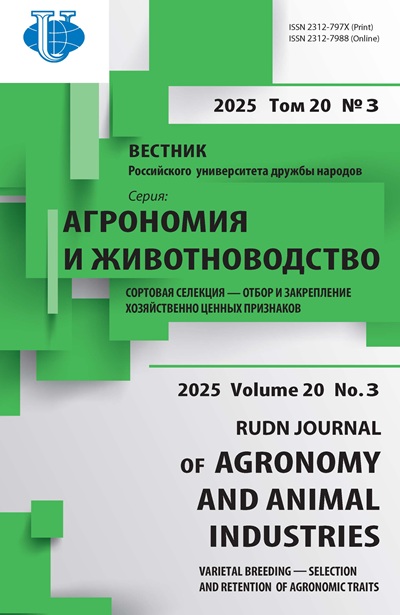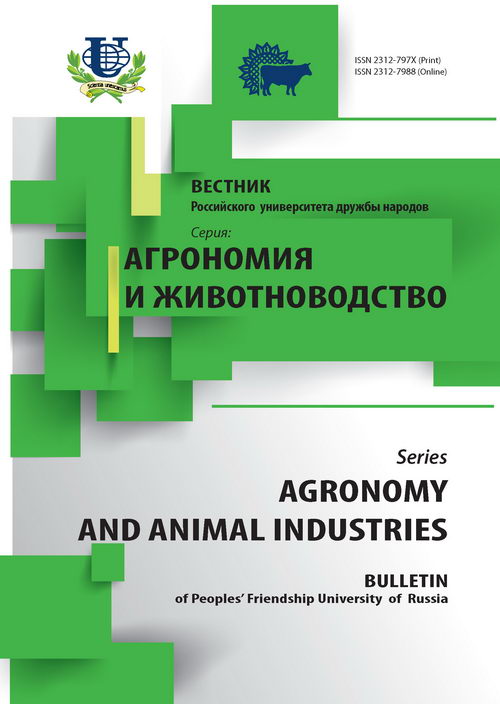Получение препаратов энтомопатогенных нематод и оценка их эффективности
- Авторы: Ахмед Мохамед Али Эль Диб -1
-
Учреждения:
- Российский университет дружбы народов
- Выпуск: № 3 (2010)
- Страницы: 24-28
- Раздел: Статьи
- URL: https://agrojournal.rudn.ru/agronomy/article/view/1544
- ID: 1544
Цитировать
Полный текст
Аннотация
В статье анализируются данные об инвазионной активности 3-х видов энтомопатогенных нематод из рода Steinernema (S. carpocapsae, S. feltiae и S. glaseri) в отношении различных стадий 2-х вредителей хлопчатника: хлопковой совки (Spodoptera littoralis) и хлопковой моли (Pectinophora gossypiella), а также в отношении личинок комнатной мухи (Musca domestica). Найдено, что наибольшей эффективностью в отношении личиночных стадий вредителей обладает вид S. feltiaе, затем S. carpocapsae и S. glaseri. Куколки в целом оказались менее восприимчивы к инвазии нематод.
Ключевые слова
Об авторах
- Ахмед Мохамед Али Эль Диб
Российский университет дружбы народов
Email: dean@agro.pfu.edu.ru
Кафедра ботаники, физиологии, патологии растений и агробиотехнологии; Российский университет дружбы народов
Список литературы
- Belton P.T., Rutherford A., Trotter D.B., Webster J.M. Heterorhabditis heliothidis: potential biological control agent of house flies in caged-layer poultry barns // J. Nematol. - 1987. - № 19. - P. 263-266.
- Geden C.J., Axtell R.C., Brooks W.M. Susceptibility of the house fly, Musca domestica (Diptera: Muscidae), to the entomogenous nematodes Steinernema feltiae, S. glaseri (Steinernematidae) // J. Med. Entomol. - 1986. - № 23. - P. 326-332.
- Henneberry T.J., Lindegreen Z.E., Forlow J.L., Burke R.A. Pink bollworm (Lepidoptera: Galechiidae), cabbage looper, and beet armyworm (Lepidoptera: Noctuidae) pupal susceptibility to steinernematid nematodes (Rhabditida: Steinernematidae) // J. Econ. Entomol. - 1995. - V. 88. - № 4. - P. 835-839.
- Henneberry TJ., Forlow J.L., Burke R.A. Pink bollworm adult and larval susceptibility to steinernematid nematodes and nematode persistence in the soil laboratory and field tests in Arizona // Southwestern Entomologist. - 1996. - V. 21. - № 4. - P. 537-368.
- Klein M.G. Efficacy against soil-inhabiting insect pests / Entomopathogenic nematodes in biological control (R. Gaugler and H.K. Kaya - eds.). - CRC, Boca Raton, FL., 1990. - Р. 195-214.
- Lindegren J.E., Valero K.A., Mackey B.E. Simple in Vivo production and storage methods for Steinernema carpocapsae infective juveniles // J. Nematol. - 1993. - V. 25. - № 2. - Р. 193-197.
- Lindegren Z.E., Henneberry T.J., Jech L.J.F., Burke R.A. Pink bollworm suppression response and field persistence of two insect parasitic nematodes // Proceedings Beltwide Cotton Conferences, San Antonio, TХ, USA. - 1995. - V. 2. - Р. 944- 946.
- Mullens B.A., Meyer J.A., Cyr T.L. Infectivity of insect-parasitic nematodes (Rhabditida: Steinernematidae, Heterorhabditidae) for larvae of manure-breeding flies (Diptera: Muscidae) // Environ. Entomol. - 1987. - № 16. - Р. 769-773.
- Poinar G.O. Nematodes for biological control of insects. - CRC, Boca Raton, FL., 1979.
- Renn N., Barson G., Richardson P.N. Preliminary laboratory tests with two species of entomophilic nematodes for control of Musca domestica in intensive animal units // Ann. Appl. Biol. - 1985. - № 106. - Р. 229-233.
- Shapiro D.L., Tylka G.L., Lewis L.C. Effects of fertilizers on virulence of Steinernema carpocapsae // Appl. Soil Ecol. - 1996. - № 3. - Р. 27-34.
- White G.F. A method for obtaining infective nematode larvae from cultures // Science (Wash. D.C.). - 1927. - № 66. - Р. 302-303.
Дополнительные файлы















